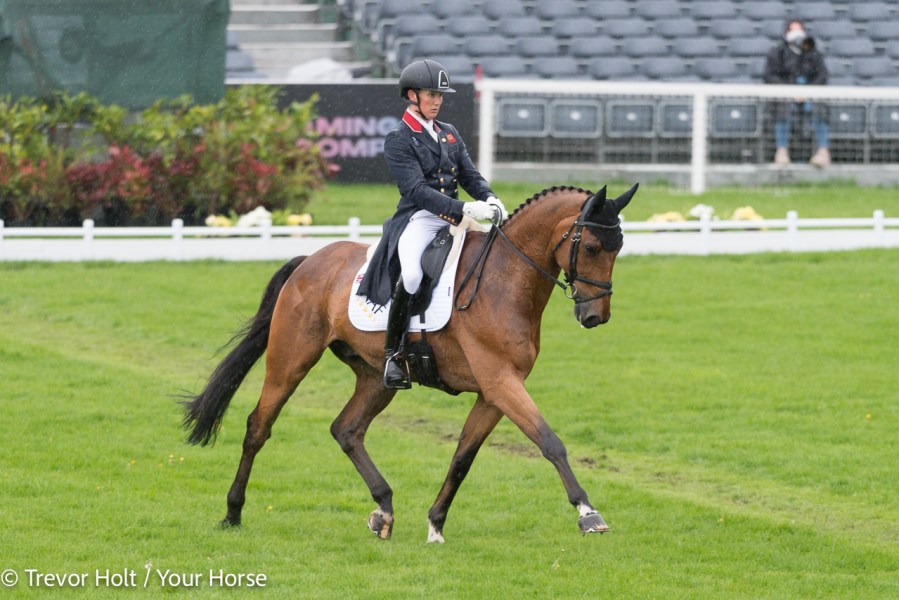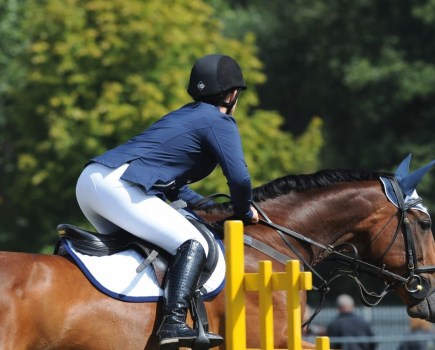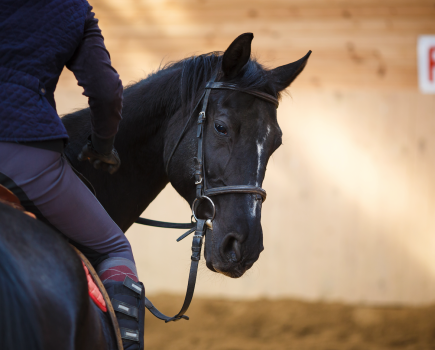You need to do everything you can to encourage your horse to maintain good back posture, as poor horse posture will affect their movement, how comfortable they are to ride, and put more wear and tear on their body, thus increasing the risk of injury. A horse with good posture will generally stand square and be well balanced. Their cannon bones should be perpendicular to the ground with the centre of mass behind the elbows and aligned below where the rider sits. When they are being ridden, the rider’s posture is very influential.
“As soon as we sit on a horse’s back the spinous processes get that little bit closer together,” explains equine sports and remedial therapist Gillian Higgins, who runs Horses Inside Out. “We also compromise the horse’s posture, affecting their balance and movement, and increase the stress on their joints, tendons and ligaments — all of which is quite depressing. So you may be thinking ‘should I stop riding my horse?’ Of course not, but what you need to do is think of yourself as your horse’s personal trainer and use exercises to encourage them to be in the best possible posture.”
Which muscles affect horse posture?
It’s important to regularly do exercises to help promote good back posture in your horse. Below are the main muscle groups involved and what you can do to help keep them in tip-top shape.
1 The head and neck
The nuchal ligament comes from the very back of the head and runs all the way along the neck to the withers. Its main function is to help hold the head and neck up. “Think of it as a strong elasticated strap running from the back of the head to the withers,” says Gillian. “It continues along the back, but becomes the supraspinal ligament.”
A simple way to illustrate how the position of your horse’s head and neck can affect the position of their back is to take a curtain pole and carefully rest it along their back. As you move your horse’s head and neck into different positions, watch how the gap between their back and the curtain pole changes.
“When their head is up the ligament within the neck becomes slack: less force is going through it so their back drops,” says Gillian. “When the horse’s head comes down the ligament is pulled taut. This pulls into the supraspinous ligament and the back comes up.”
2 Position of the hindlegs
The second way your horse supports good back posture is all to do with their hindlegs – and where they are in relation to their body. In-hand, ask your horse to halt, and look where their hindlegs are in relation to their pelvis.
“If they stand with their hindlegs out behind them, this will extend their spine and their hindlegs won’t be able to support their back,” explains Gillian. “When your horse’s hindlegs are underneath their body, they’re more likely to be able to support their back, and be a little more flexible too.”
Try this exercise:
- Stand up and then bend at the waist as though you’re a horse (your arms can hang – you don’t need to be on all fours).
- Extend your back by lifting your head in the air and tilting your pelvis so your bottom is sticking out.
- Walk on the spot.
- Now change to a good posture: recruit your abdominals and tilt your pelvis so your knees come forwards a bit as you round your back.
- Walk on the spot again.
- This should now feel easier to do, highlighting how the position of their hindlegs influences your horse.
Exercise: stepping backwards
This exercise connects the hindlegs and the body — it’s like collection in reverse. In-hand, ask your horse to step backwards for around 10 steps with their head and neck lowered.
“To be effective, the backward steps need to be the same speed as walking forwards,” advises Gillian. “As your horse steps backwards you’ll see they bring their hindlegs underneath their body more, and you’ll see greater flexion through the lumbosacral junction and all their hindlimb joints.”
Try to incorporate this exercise into your daily routine, for example ask the horse to back up for a few steps on the way to the field when you’re turning out.
3 The thoracic sling
There’s no direct bone connection between your horse’s forelegs and the rest of their body — their front legs are like two bony pillars. Connecting the thorax (chest area) to the front legs are the thoracic sling muscles. These come from the underside of the shoulder blade and attach to the cervical vertebrae on the first eight ribs, a bit like a hammock.
“To support good back posture your horse should be well toned through their thoracic sling muscles. If they’re long and weak through this area you’ll often see a larger hollow just behind the withers,” states Gillian.
Exercise: canter poles
Working your horse over canter poles is great for strengthening their thoracic sling. The rocking forward and back motion of canter is like a sit-up for your horse. Set out your poles on the floor with three of your normal walk steps between each one. As you ride over the poles, the footfalls alter slightly; it’s technically not canter anymore as the hindlegs come through together. Once you and your horse are confident cantering over poles on the floor you can raise alternate ends, and then both ends.
4 Back and abdominals
It’s important to have a balance between well-toned abdominal muscles, as they support the back, and strong back muscles. Put simply, the muscles above the spine and behind the bony column of the hindlimb help to create extension. They extend the back, neck and hip joint, and push your horse forwards, extending their hindlegs out behind them.
“The muscles and ligaments under the spine, in front of the hip joint, underneath the pelvis and in front of the bony column of the hindleg help to create flexion,” explains Gillian. “This flexor chain of muscles are responsible for flexing the spine and hip joint, and bringing the hindlegs underneath the body.”
Exercise: walk poles
Walking over poles, ridden or in-hand, is great for improving your horse’s hoof to brain coordination. It also encourages the horse to flex their joints as they lift their legs. Set out five poles, with three of your heel-to-toe steps between each. As you reach the first pole try not to interfere and instead leave your horse to work it out for themselves.
- If you’re riding this exercise, ride on the buckle end as it’s your horse’s responsibility to sort out their legs out.
- Allow your horse to lower their head and neck as they walk over the poles.
- Resist the temptation to help them and simply give them time to work it out.
- Walk over the poles flat on the floor or raised at alternate ends.
Exercise: trotting poles
Trot is a completely different gait because essentially your horse is jumping from one diagonal pair of legs to another. Their whole body, front to back, stays virtually level and symmetrical. Working your horse over trotting poles encourages them to push equally off each hindleg. As you ride over the poles resist the temptation to push for a bigger trot – wait for the pole to come to you, and let your horse change their posture.
Why good horse posture is so important
You know that your own posture can affect your performance, movement, symmetry, breathing, comfort and musculoskeletal health, and it’s exactly the same for your horse. To help improve your understanding, try this:
- Sit on the edge of a seat.
- Tilt your pelvis as far forward as you can, extending and hollowing your back.
- Look up at the ceiling and push your shoulders back so you’re extending your back as far as you can.
- Now add some lateral flexion – take your left armpit towards your left hip and then repeat on the right.
- Now look straight ahead and tilt your pelvis the other way.
- Straighten your spine and flex it a bit so you can feel your abdominals recruit.
- Now repeat number four. This should be much easier to do.
This is exactly the same for your horse. If their back is in an extended position they’ll have reduced lateral flexion and less ability to perform.
How to achieve good horse posture
To encourage good horse posture, spend more time riding in walk. Vary between a longer walk and a shorter walk, as well as incorporating some lateral movements. This is a great way to warm up during a schooling session.
“Use lateral work to encourage your horse to relax if they’re tense. The action of stepping across and under their body is great for improving their posture,” suggests Gillian. “Also canter, as this gets your horse’s back really moving and the blood pumping, helping to warm their muscles up. All horses benefit from cantering early on in their training session; the trot always looks more forwards and expressive afterwards.”
it up straight, don’t slouch, shoulders back – we know the importance of good posture for ourselves, but what about our horses?
In layman’s terms, a horse with good posture will generally stand square and be well balanced. His cannon bones should be perpendicular to the ground with the centre of mass behind his elbows and aligned below where the rider sits.
6 ways to improve horse posture
As well as the exercises above, there are other things to check and do when it comes to supporting good horse posture.
1 Book a physiotherapist
Not only will a physio be able to spot muscular issues, but they’ll also be able to alleviate soft tissue discomfort and associated compensations, helping to improve his posture. To find a qualified equine physiotherapist visit www.acpat.org.
2 Do regular carrot stretches
Carrot stretches encourage your horse to stretch through their neck and back, developing balance, coordination and muscles. Make sure they are fully warmed up before you begin. Here’s a simple carrot stretch from BHS instructor Vikki Hayton for you to try.
3 Ride serpentines
Working in walk and trot, incorporate three or four loop serpentines into your schooling sessions. The shape of the loops will increase the movement and bend through your horse’s body. Serpentines are simple and effective!
4 Switch surfaces
Different surfaces can impact on your horse’s movement and his posture. Too deep and they have to concentrate on their balance, as well as propelling themselves forward. Uneven ground means your horse will be unable to apply equal weight to their footfalls. Flat, non-shock absorbing surfaces, such as tarmac, can also compromise posture. The solution is to cross-train your horse on varied terrain, always making sure it’s safe terrain to ride on avoiding deep, rutted deep surfaces. It’ll be beneficial as he’ll learn to cope with the changing footing.
5 Check the fit of your tack
Ill-fitting tack can result in postural compensations, which can lead to lameness. For example, if a saddle pinches on one side, the horse wearing it won’t work symmetrically, building up uneven muscle and applying strain on his legs. Bridles also have a part to play in this. Bridle fit is often overlooked despite the huge influence it can have on our horses’ performance and welfare, according to equine vet and researcher, Dr Rachel Murray. Read more about her research here.
6 Consider your own posture
How you sit in the saddle influences your horse’s posture too. How aware are you of your position in the saddle? Performance analyst Russell Guire explains how to check your position here. It is really worth doing this, as the improvements you’ll make and the benefits your horse will have in their performance from carrying a balanced, symmetrical rider could be huge.
Main image: Tom McEwen and Toledo de Kerser in action at Badminton Horse Trials 2023. The perfect image of good posture in both horse and rider! Image by Trevor Holt
Related articles
- Poor topline: what it is, plus how to build and develop the correct muscles
- Why you should think about your posture when hacking, plus three exercises to improve it
- Bridle fit and horse head anatomy: everything you need to know *VIDEO*
- What every rider needs to know about hacking a horse on different terrain
- Saddle fit: how to check it’s correct for you and your horse *VIDEO*








